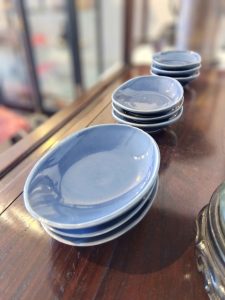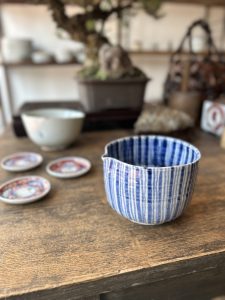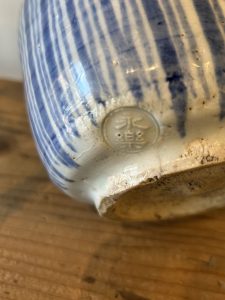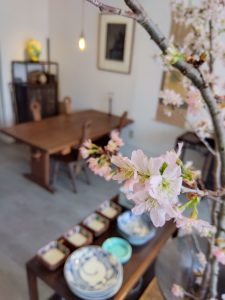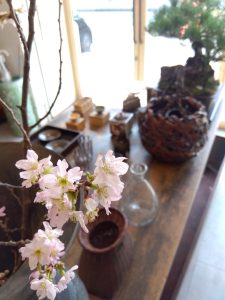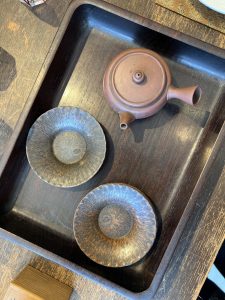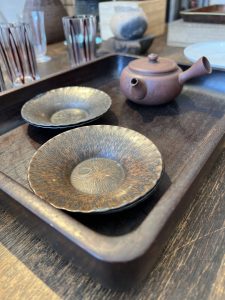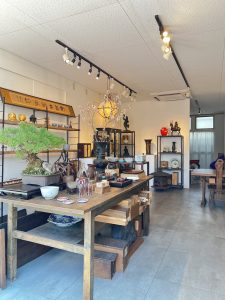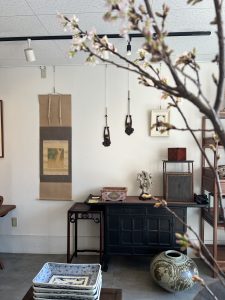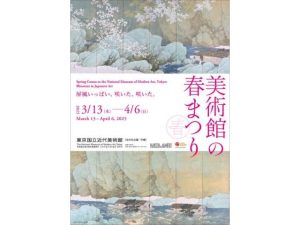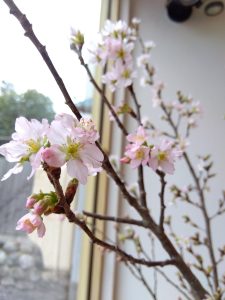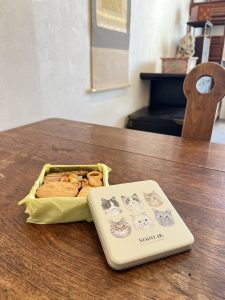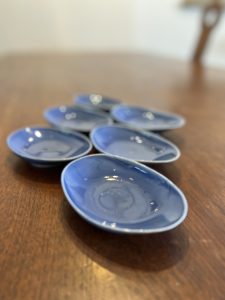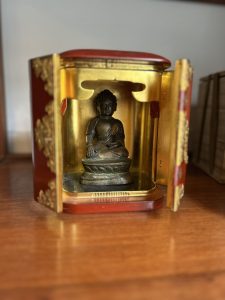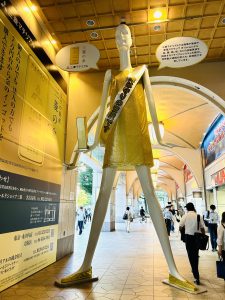春を告げる雷(愛知県名古屋市千種区姫池通 骨董買取 古美術風光舎)
2025.03.25
晴れていますが、空は霞んでいます。今年も黄砂が飛んできましたね。花粉よりも黄砂の方がダメなようで、体調も微妙です…。
ご存知の通り、黄砂は、中国大陸奥地のタクラマカン砂漠やゴビ砂漠などで舞い上がった砂ぼこりが飛んでくる現象です。上空の強い風によって、遠く離れた日本へも飛んできます。黄砂が最も多く観測されるのは、春(3~5月)です。昨日は急なゲリラ豪雨あり、もうそんな時季が来たのだな…と思いました。
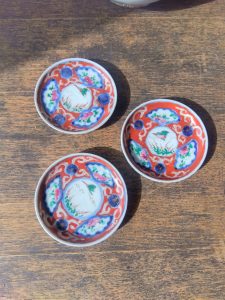
週末は気温も下がり花冷えの予報。周期的に雨が降り、気温が高くなったり低くなったりと変化の激しい今日このごろ。「ひと雨ごとに暖かくなる」という言葉がぴったりの季節です。
この時期に起こる現象といえば、俳句の季語にもなっている「春雷(しゅんらい)」。
雷といえば真夏のイメージが強いかもしれませんが、この季節にも雷は鳴ることがあります。文字通り、春の訪れを伝えてくれる雷です。
季節の移り変わりをあらわす七十二候にも「雷乃発声(かみなりすなわちこえをはっす)」があります。名前がとても長い七十二候です。たぶん、七十二候の中で一番長いのではないでしょうか。その分インパクトの強い七十二候ですが、読んで字のごとく遠くで雷の音がしはじめる、という意味です。
ところで、雷の語源はなんでしょうか。
古来、日本で「雷」は「神鳴り」と表記され、文字通り、神の力で引き起こされる現象と考えられていました。
鬼の姿で背中には太鼓を背負い、それを打ち鳴らす雷神。今では空想上のものだと思われていますが、昔は本当に雷神が存在していて、雷を鳴らしていると考えられていました。
当時の人々はどれほど恐ろしかったことか。かの清少納言も「枕草子」の中でその脅威について書き記しています。 彼女もかなり苦手だったみたいですね。
おまじないで『くわばら、くわばら』という言葉があります。おばあちゃん世代は使ったかもしれない「くわばら、くわばら」というこのくわばらとは何のことでしょう?
『くわばら、くわばら』とは雷除けのおまじないの言葉ですが、実は地名なのです。
これは平安時代、流刑された菅原道真がその恨みから宮中に雷を落とし、その中で唯一「桑原」という土地だけ雷が落ちなかったという話に由来しています。
道真の死後、次々と不幸が見舞われ、京の町中あちらこちらに何度も雷が落ちたのですが、一ヵ所だけ落ちなかった場所があり、それが桑原=くわばら、だったのです。それ以来、町中の人たちは、雷が鳴るとこの「くわばら、くわばら」と唱えるようになり、おまじないが浸透していったようですよ。
春を告げる「春雷」。
季語ということもあって語感はとても風情がありますが、季節の変化、天気の変化には少々疲れてしまうことも。ですが、桜が咲き始め、遠くの空では雷が鳴り始める…。毎年順序よく流れていく季節は、どこか安心させてくれるような気がします。
ではでは、また。(スタッフT)
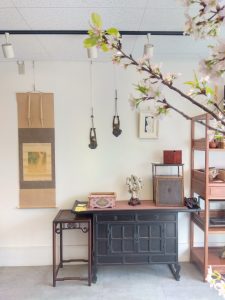
※この度、古美術風光舎では《うつわと骨董展》を店舗にて開催いたします。
《うつわと骨董展》
4月5日(土) 10:00~17:00 開催
4月6日(日) 10:00~17:00 開催
また、4月12,13日は覚王山春祭りも開催されており、春の覚王山界隈はとても賑やかに華やいでおります。風光舎も皆さまのご来店を楽しみにお待ち申しあげておりますので、お気軽にお立ち寄りください。
It is sunny but the sky is hazy. Yellow dust has flown in again this year. It seems that yellow sand is worse than pollen, and my health condition is delicate…
As you know, yellow sand is a phenomenon in which dust from the Taklamakan Desert and the Gobi Desert in the interior of the Chinese continent is blown in. Strong winds in the sky above the country can carry it to Japan, which is far away. DSS is most frequently observed in spring (March to May). Yesterday’s sudden downpour made me realize that the season has already arrived….
The forecast for the weekend is for cooler temperatures and cooler flowers. These days, it rains periodically, and the temperature changes rapidly from high to low. It is the season of “warmer weather with each rainfall.
The phenomenon that occurs at this time of year is “spring thunder,” which is also a seasonal term in haiku.
Thunder may have a strong image of midsummer, but it can also occur during this season. Literally, it is the thunder that signals the arrival of spring.
The 72nd season, which represents the changing of the seasons, also includes “kaminari nokoe hahassu” (雷乃発声, meaning “the sound of thunder”). It is a very long-named 72-weather season. It is probably the longest of the 72 seasons. As you can read, it means that the sound of thunder begins to be heard in the distance.
By the way, what is the origin of the word “thunder”?
Since ancient times, “thunder” in Japan has been written as “kaminari,” literally meaning “divine sound,” and was thought to be a phenomenon caused by the power of the gods.
The god of thunder, in the form of an ogre, bears a drum on his back and beats it to the ground. Nowadays it is thought to be imaginary, but in the old days it was believed that the god of thunder really existed and was sounding the thunder.
How terrifying it must have been for the people of that time. Even the famous Sei Shonagon wrote about the threat in her “Pillow Book. It seems that she was not very good at it either.
There is a word “Kuwabara, Kuwabara” as a spell. What does “Kuwabara, Kuwabara” mean, which grandmother’s generation might have used?
Kuwabara, kuwabara” is a word for a spell to ward off lightning, but it is actually the name of a place.
It is derived from a story that during the Heian period (794-1185), Michizane Sugawara, who was exiled from Japan, caused lightning to strike the court out of resentment, and that Kuwabara was the only place among them where lightning did not strike.
After Michizane’s death, the town of Kyoto was struck by lightning many times, but there was only one place where lightning did not strike, and that was Kuwabara, or Kuwabara. Since then, people in the town started chanting “Kuwabara, Kuwabara, Kuwabara” whenever lightning strikes, and the spell seems to have spread.
Spring thunder” heralds the arrival of spring.
The word is seasonal and has a very elegant feel to it, but the change of seasons and weather can be a bit tiring. However, the cherry blossoms begin to bloom and thunder begins to rumble in the distant sky…. I feel that the seasons, which flow in order every year, somehow reassure me.
See you soon. (Staff T)
We are pleased to announce that we will hold the “Utsuwa to Kotto Exhibition” at our store.
The exhibition will be held on April 5 (Sat.).
April 5 (Sat) 10:00-17:00
Sunday, April 6, 10:00-17:00
The Kakuozan Spring Festival will be held on April 12 and 13, and the Kakuozan area will be very lively and colorful in spring. Fumikosha is looking forward to seeing you at our store, so please feel free to stop by.
*****************
ご実家の整理やお片付けなどをされている方のご相談などが多くございます。
お片付けなどくれぐれもご無理のないようになさってくださいませ。
風光舎では古美術品や骨董品の他にも絵画や宝石、趣味のお品など様々なジャンルのものを買受しております。
お片付けをされていて、こういうものでもいいのかしらと迷われているものでも、どうぞお気軽にご相談下さいませ。
また風光舎は、出張買取も強化しております。ご近所はもちろん、愛知県内、岐阜県、三重県その他の県へも出張いたします。
まずは、お電話お待ちしております。
なお、毎月21日の持込鑑定会では無料鑑定・買取・持込など、ご予約なしで承っております。
ご近所の皆さま、ご遠方のみなさまも、お気軽にお越しくださいませ。
愛知県名古屋市千種区姫池通
骨董 買取【古美術 風光舎 名古屋店】
TEL052(734)8444
10:00-18:00 OPEN
#出張買取#骨董#古美術#骨董品#絵画#版画#茶道具#刀剣#彫刻


